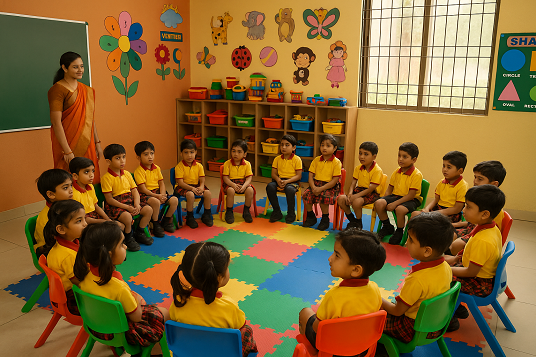Parents fear: If preschool is this costly, what about higher education?
In cities like Pune, the cost of enrolling a child in pre-primary school has become a major concern for parents. While early childhood education is essential for a child’s development, its rising cost is forcing families to rethink their budgets and priorities. Today, preschool fees in private schools range from ₹50,000 to even ₹1.5 lakh per year—excluding other expenses like uniforms, books, and transport.
Why Are Parents Worried?
Parents want quality education for their children, but the high fees are putting financial pressure on middle-class and lower-income families. Some parents are even delaying or skipping pre-primary education, especially when free anganwadi centres are far from their homes.
Swara Jakate, a mother from Pune, shares her experience:
“I enrolled my child for pre-primary education. Even when he was 3 years old, people advised us to send him to school, but due to high fees, it wasn’t possible. The anganwadi was far from our home, so I taught him at home. Now he’s 5, and we had to send him to school. The fees are almost ₹50,000, and there are other costs too. But education is important. I was shocked that I completed my full degree in ₹50,000, and now I have to spend the same just for pre-primary. How can education be affordable for every child?”
Another parent expresses his view :
“We want to give our children quality education, so we chose a private school. But with two kids, managing the fees is becoming difficult. We even worry about how we’ll handle their college education later,” says Akshay Suryavanshi, a parent from Pune.
Why Do Parents Choose Private Schools?
Though government-run anganwadis and municipal schools offer low-cost or free education, many parents turn to private schools for better facilities, English-medium teaching, trained staff, smart classrooms, and activity-based learning.
According to reports, average preschool fees in Pune range from ₹50,000 to ₹1,50,000 per year. Some premium schools charge even higher. And this is just for nursery or kindergarten—there are still many more years of schooling ahead.
In 2021–22, 43 out of every 100 students from Grade 1 to 12 were enrolled in schools under private management (educationforallindia.com). This shows the growing preference despite the cost.
What About Poorer Families?
Back in 2014, over 70% of children aged 3–6 years were enrolled in pre-primary education in India. However, around 20 million children were still left out, and 35% of them belonged to the poorest families.
In 2024, 1.17 crore children across India were identified as not enrolled in primary, secondary, or senior secondary education. While government schemes exist, affordability and access remain major barriers.
Approximately 26.4% of India’s population is estimated to be living below the poverty line, according to a study cited by The News Minute.
Adding to this concern is a broader issue of economic inequality. According to the same study, estimates suggest that roughly 373 million people in India live below the poverty line, though this figure varies depending on the methodology. Some reports suggest as low as 2.5%, while others estimate poverty levels as high as 29.5%. This wide range shows that a large section of India’s population may not be financially equipped to bear rising education costs, especially at the pre-primary level.
Is Education Becoming a Luxury?
Parents are now asking: If preschool itself is so expensive, what will happen when these children grow up and reach college or university? While inflation and rising costs are real, incomes haven’t grown at the same pace, especially for middle and lower-income families.
The fear is simple yet serious: Is education slowly becoming a product only the rich can afford?
Education is meant to be a basic right, not a luxury. But with private school fees soaring even at the nursery level, many parents feel trapped between their child’s future and financial stress. There is now an urgent need for:
– Stronger investment in public schools
– Improved quality in government-run anganwadis
– Fee regulation policies for private institutions
Only then can we hope for a future where every child—rich or poor—gets equal access to quality education.








